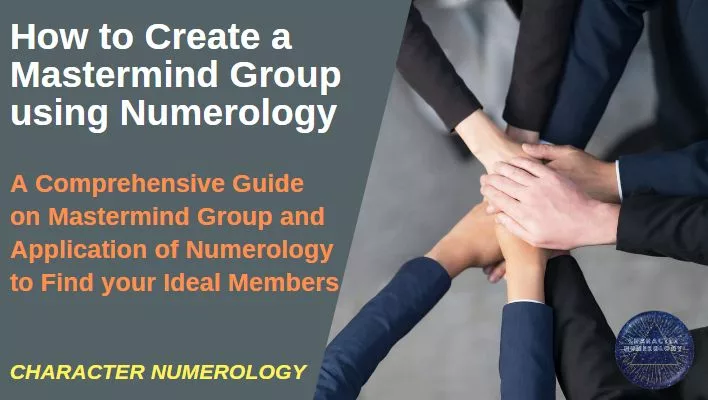If you are seeking partners for a business venture or assembling a team for an upcoming project, one of the first things on your mind is determining the right individuals to collaborate with. In this article, we will explore the process of forming a mastermind group and how utilising numerology can contribute to the success and synergy of you and your team. Discover how to create a mastermind group that fosters growth and achievement in this comprehensive guide.
What is the Purpose of a Mastermind Group?
But first, what is a mastermind group and its purpose?
A mastermind group is a group of individuals who come together with a common goal of supporting each other to achieve their personal and professional goals.
And the purpose of a mastermind group is to provide a supportive and collaborative environment where members can share their knowledge, skills, and experience to help each other overcome challenges and achieve success.
Members of a mastermind group will meet regularly to share their progress, discuss challenges they are facing, and provide feedback and support to each other.
By working together in this way, members can leverage the collective wisdom and resources of the group to overcome obstacles and achieve their goals more quickly and effectively than they would on their own.
Why do you need a Mastermind Group?
Knowing what a mastermind group is and its purpose should give you a fair idea of why you should form or be part of a mastermind group.
So what are the benefits of a mastermind group? There are several benefits, and some of these are:
Accountability – Being part of a mastermind group means that you have accountability partners to watch over you, and you will feel more motivated to work towards your goals more quickly.
Leveraging Effect – You will have access to a network of individuals with diverse knowledge, skills, experience, connections, or resources that may take you years to acquire if you are on your own.
Diverse Perspective – When you work together in a mastermind group, you will be exposed to new ideas that you may not have the means to consider if you are on your own. The various background and experiences of your mastermind group members may potentially generate new ways of doing things that can be more efficient and effective.
Supportive Environment – It is a give and take, where members of a mastermind group are committed to helping one another to succeed.
As you can imagine, it is essential that everyone should be part of a mastermind group at some point in life.
History of Mastermind Group
The concept of a mastermind group can be traced back to the early 20th century when it was popularised by Napoleon Hill, an American author and self-help guru.
Hill is perhaps best known for his book “Think and Grow Rich” which has sold millions of copies worldwide and is considered a classic in the self-help genre.
Before “Think and Grow Rich”, it was his earlier book “The Law of Success”, which first brought forth the idea of a mastermind group.
In his book, Hill describes the concept of a “Master Mind” as a group of individuals who come together in a spirit of harmony and cooperation to achieve a common goal.

According to Hill, the power of a Master Mind is far greater than the sum of its parts, and members can achieve success more quickly and easily by working together than they would on their own.
Hill’s ideas were based in part on his own experience as a journalist and writer, as well as his interviews with some of the most successful people of his time, including Andrew Carnegie, Thomas Edison, and Henry Ford.
These individuals were known for their ability to surround themselves with talented and motivated people who could help them achieve their goals, and Hill saw the potential for anyone to benefit from this approach.
What is the Ideal Size of a Mastermind Group?
The ideal size for a mastermind group can vary depending on the goals and needs of the members. It is recommended that a mastermind group should be between 4 to 9 in a group.
It is because you want to keep the group manageable. Too many people can mean it is harder to coordinate and get everyone into the same meeting since everyone has their own schedule.
Location for offline meetings can also become an issue if the group is too large, although meeting online via Zoom, Skype, or other online meeting platforms is always an option.
Nevertheless, nothing beats face-to-face meetings to really establish that connection between individuals.
Another reason for keeping the mastermind group relatively small is to avoid redundancy.
Having a mastermind group of between 4-9 people is usually more than sufficient to incorporate a range of experience, knowledge, and expertise that the mastermind group can leverage from one another.

Anything more than that may increase the probability of creating duplicates and conflicts.
The last reason to keep the group within this range is to promote intimacy. Building trust in a small group is faster as the members have more opportunities and feel more comfortable sharing thoughts on their goals, challenges, or feedback.
A tightly-knit group will help foster a sense of genuine connection among members, promoting a spirit of harmony and cooperation.
Who should you include in a Mastermind Group?
The question arises of who you should include and invite into your mastermind group. Or if you are invited to join a mastermind group, will you be the right fit?
It is necessary to understand the purpose of why you want to have a mastermind group.
If you are venturing into a business, the choice of people with the knowledge, experience or skillset will be different from a mastermind group focusing on personal development, for instance.
Think about what you can offer to the group in terms of your experience, knowledge and skills.

And in the reverse direction, what do you need from others to help you to succeed faster?
A starting point to do anything is to develop a burning desire. Ask yourself, “What do I really want?” and imagine yourself already in the state you want to be.
As you practice this every day, you will begin to vibrate at a higher frequency and attract the people and things you need to help you succeed.
How to Form a Mastermind Group
After determining your goals, understanding the purpose of a mastermind group, and recognising your knowledge, skills and experience gaps, you are in a position ready to seek out individuals who share similar objectives and possess a similar understanding of the group’s purpose.
Remember, a mastermind group is a carefully curated group of individuals coming together to achieve success together. You will want members in the mastermind group who has something that you know you can leverage while also sharing your experience, knowledge, or skills.
As such, you want to invite the right people. These are people who share similar interests as you.
For example, if you are starting an online business, you can keep a lookout for people you know who may also be doing something similar.
It can be people who are venturing into a different niche as you, or it can also be the same niche.
Another interesting example is if you are a financial consultant. There are two ways to form a mastermind group.
The first is to form a mastermind group where the members are all financial consultants. It means everyone in the group has the same common goal to improve their profession.
The second way is to create a mastermind group comprising members of different disciplines or industries.
It enables you to tap into the expertise that you do not have. For instance, you may want to have a doctor, lawyer, content creator, digital marketer, or personal branding specialist in your mastermind group.
Their expertise will prove to be very useful in your role as a financial consultant.

There is an abundance of opportunities to collaborate in many ways, and the overarching principle that all members of a mastermind group must have is that everyone should work together in a spirit of harmony and cooperation.
And that brings up a point on how will you know whether a potential member is trustworthy and has the right attitude or character that you can work with.
That is where numerology can help us in choosing our members.
Applying Numerology in Choosing your Mastermind Group Members
Numerology can assist us to understand the personality traits or behavioural style of yourself and the members in your mastermind group or potential members if you are starting out to form a group.
By understanding your core numerology number vibration, which we call the Character Root Number, you will know how you usually operate.
For instance, if you are a Character Root Number 4 (Mastermind) personality, you are very detailed and hardworking.
You are a doer and have a strong inclination towards getting your facts right. Planning, researching, strategising, and organising are your strengths.
On the other hand, presentation and leading people are likely not your immediate strengths.
Or if you are a Character Root Number 2 (Communicator) personality, communication is your thing.
You are a natural talent in presenting yourself. You shine on stage and enjoy the limelight. But you are generally weaker in the details.

In some ways, the number 2 envies the number 4, and vice versa. While everything is learnable, it takes time and effort to acquire a skill.
Building a Diverse Mastermind Group with Numerology
And that is why in a mastermind group, you want diversity to leverage from each other.
So having members of different Character Root Number personalities is highly beneficial to bring varying perspectives to solve problems and to develop solutions.
It is not just about bringing in people with different experiences and expertise, you also want to consider having a diverse range of personality traits in your group.
Achieving this also enables the members to learn a trick or two from each other, such as how an individual who is a Character Root Number 4 can learn communication skills from a Character Root Number 2.
Therefore, as you proceed to form your mastermind group, you may want to invite potential members comprising of different Character Root Number personality types.
Start by calculating your Character Root Number and understand your number vibration. Then assess the personality type of members you want in your mastermind group.
Do you want someone who can lead, someone who is front-facing, someone who is highly energetic, somehow who is meticulous, someone who has great intuition and foresight, or someone who is vocal and charismatic?
Ideally, you will want all of them. Nevertheless, it also depends on your goal of having a mastermind group.
And you may not find all of them and it takes quite a bit of luck based on who you know. But at least you know how to assess a person faster if you know how to use numerology.
How to Calculate your Numerology Number?
To calculate your Character Root Number, sum and reduce the numbers in your date of birth into a single digit. The number defines your primary personality trait.
For example, if you are born on 8 May 1994, your Character Root Number will work out to be 0+8+0+5+1+9+8+7 = 38 = 3+8 = 11 = 1+1 = 2. Being a Character Root Number 2 can mean that you need members who are more meticulous than you.
You may also want members who can drive things and help to make decisions (Character Root Number 1). You will also want members who can help to execute and drive outcomes faster (Character Root Number 3).
Choosing your Mastermind Group Members
Who you can invite to be a member of your mastermind group depends on who you know and whether they share similar interests and understand the purpose of being part of a group.
And then, you want to verify whether they may be a right fit in your mastermind group by knowing their Character Root Number.
If you are a Character Root Number 2 personality, partnering with another number 2 may not necessarily add much value unless the potential member has exceptional communication skills that you can learn from and brings unique knowledge, skills, and experience that you can leverage.
Else, consider looking for people who can help fill your weaker areas. The following is a summary of the various Character Root Number personality traits.
| Character Root Number | Personality Traits |
|---|---|
| Character Root Number 1 (Leader) | Comfortable with front-facing, decision-maker, vocal in giving their views, creative in generating ideas, but may not be too detailed and sympathetic. |
| Character Root Number 2 (Communicator) | Eloquent, persuasive, empathetic, friendly and approachable. Good at presenting themselves, prefer to solve things via dialogue, but not too detailed. |
| Character Root Number 3 (Energiser) | Enthusiastic, creative, lively, and strong in execution. Preference to get things done quickly. Does not like to wait. Can be impatient and temperamental. Weaker in giving sufficient thought towards things in exchange for speed. |
| Character Root Number 4 (Mastermind) | Thinker, planner, strategist, organiser. Meticulous in his work, but potentially a perfectionist. Tendency to overthink. Weaker in presentation skills, focus a lot on details. |
| Character Root Number 5 (Conqueror) | Considered a leader of leaders. Logical and practical thinker, curious, and loves freedom. Clear in setting objectives. Jack of all trades, ambition to be everything can be a weakness. |
| Character Root Number 6 (Sage) | Highly intuitive, able to foresee problems or consequences fastest. Good in visualisation. Creative, knowledgeable and wise. Pragmatic, consider the viability of things usually from a resource or funding perspective first. |
| Character Root Number 7 (Celebrity) | Charismatic and sociable. Usually popular and enjoys better luck. The attractive vibration helps greatly in networking and establishing connections. Not very decisive. |
| Character Root Number 8 (Guardian) | Hardworking, serious, and loves challenges. Highly responsible, but feels and displays signs of stress easily. Wants to be in control. |
| Character Root Number 9 (Entrepreneur) | Optimistic, open-minded, imaginative, creative. Quick to spot opportunities. Weak in governance and may appear sluggish. |
Advanced Selection of Mastermind Group Members
The section here is for you if you are willing to go through a more advanced level to find your mastermind group members using numerology.
As you go through the table above, you may find that you can fit into more than one Character Root Number.
And this is completely natural because if you construct your numerology chart, you will find other numbers surrounding your Character Root Number.
These number vibrations also play a part in shaping and influencing your personality. The Character Root Number only depicts your primary characteristic or approach to handling things.
Thus, to have a refined view of whether a potential member is a good fit to join your mastermind group, it is recommended to analyse your numerology chart, those of your existing members (if any), and the potential members’ chart. It will help you gain a more nuanced understanding of everyone’s characteristics.
Analysing a numerology chart will also help you to further validate and confirm the potential member’s character against what you thought you knew about that person through your earlier interaction.
You may also do a numerology compatibility study to determine whether you will work well with a potential member.

The possibilities are vast when we study numerology charts, and it will not be practical to explain the permutations in this article.
As a simple illustration to provide the context, suppose you look at the numbers in your numerology chart and find that you do not have a number 2, it suggests that you are less adept in presentation or public speaking.
Therefore, it can be advantageous to seek out individuals who can complement your weaknesses in these areas. By doing so, you can build a well-rounded mastermind group with a diverse range of skills and expertise.
How to run a Mastermind Group?
Forming a mastermind group takes time as you want to be really selective and careful in choosing your members. Using numerology to find your mastermind group members can help speed things up and assist you to make more informed decisions.
But after you have formed your mastermind group, your next question would be how to run it. The following are some pointers to think about.
Group Rules
Establishing clear rules and guidelines can help ensure that a mastermind Group is effective, efficient, and supportive of all of its members. Here are some group rules that you may want to consider setting for your mastermind group:
Confidentiality: Members should agree to keep all discussions within the group confidential, and not share any personal or sensitive information with others outside the group.
Active participation: Members should commit to attending all meetings, actively participating in discussions, and contributing their ideas and insights.
Constructive feedback: Members should provide feedback and suggestions in a constructive, supportive manner, focusing on solutions rather than criticism.
Being respectful: Members should communicate respectfully and professionally, avoiding personal attacks or disrespectful language.
Time management: Members should agree to arrive on time for meetings and respect each other’s time by staying on topic and avoiding tangents.
Accountability: Members should hold themselves and each other accountable for meeting their goals, following through on commitments, and taking action towards progress.
Open-mindedness: Members should approach discussions with an open mind, being receptive to new ideas and perspectives.
Non-competitiveness: Members should avoid competing with each other or trying to one-up each other, and instead focus on collaboration and support.
Problem-solving focus: Members should prioritise problem-solving and solution-seeking in their discussions, rather than simply venting about problems or challenges.
Growth mindset: Members should approach the group with a growth mindset, focusing on learning, personal development, and continuous improvement.
These are just some of the group rules you may want to consider for your mastermind group. It’s important to establish rules that are tailored to your group’s specific goals and needs and to ensure that all members are in agreement and committed to following them.
And at the start of each mastermind group meeting, it is also essential to review the group rules to ensure that all members are reminded of them and committed to following them.

By establishing a process for reviewing these rules at the beginning of each meeting, you can help ensure that everyone is on the same page and that the group is operating effectively and efficiently.
This can also provide an opportunity to address any questions or concerns that members may have about the rules, and to make any necessary updates or changes to better meet the group’s evolving needs.
Meeting Frequency
The meeting frequency for a mastermind group can vary depending on the group size, goals to be achieved, members’ meeting availability, and other logistical considerations.
A recommended approach is to meet once every two weeks, or at least once a month.
It is more balanced whereby meeting too frequently (such as once a week) will be too overwhelming and may not allow members sufficient time to work on what was discussed from the previous week.
On the contrary, meeting too infrequently may reduce the momentum, accountability and motivation of the group.
In general, it is essential to establish an agreeable meeting frequency amongst members so that everyone feels comfortable to have sufficient time to implement the ideas and strategies discussed during the meetings, while also providing regular check-ins and accountability to keep members on track with their goals.
Time Limit
It is important to establish a clear timeframe for the mastermind group, which can typically run from six months to a year.
During this time, members should work together towards their goals, providing support and insights to one another.
At the end of the established timeframe, the group should get together to decide whether to continue or disband.
It is possible that some members may choose to leave due to time commitments or other reasons, while others may decide to continue.
In an ideal situation, a mastermind group may run indefinitely as long as the members are able to cooperate effectively and are in harmony with one another.
However, it is important to regularly evaluate the effectiveness of the group and ensure that all members are still committed and able to contribute to the group’s success.
The group may also elect to take a hiatus before reconvening, allowing everyone to recharge and reset after meeting consistently for an extended period.
This break can provide valuable time for reflection, introspection, and personal growth, enabling members to return to the group with renewed energy and fresh perspectives.

As the group evolves and members’ goals change, it may be necessary to adjust the group’s structure or establish a new timeframe to ensure continued progress and success.
Meeting Structure
The structure or conduct of a mastermind group can vary depending on the needs, goals, or purpose of the group. Nevertheless, here is a common structure that may be referred to as a starting point:
Check-in: Begin the meeting by having a roundtable update where each member will share a brief update on their progress since the last meeting, any challenges they have faced, and their goals for the upcoming week or month.
Hot seat session: This is a key part of the meeting where one member is rostered to be in the “hot seat” and shares a particular challenge, opportunity or decision they are facing. The other members then offer their feedback, insights, suggestions and experiences to help the member in the hot seat gain clarity and develop a plan of action.
Group discussion: This is an open discussion where members can share any topics, insights, or ideas that may be relevant to the group. It can also be a time for brainstorming, sharing resources or tools, and discussing group projects or goals.
Accountability: This is a time to check in on progress towards individual and group goals, and to ensure that members are accountable to their commitments made in previous meetings.
Closing: End the meeting with a summary of the key takeaways and action items, as well as any announcements or updates for the group.
Mastermind Group Roles
Roles should also be assigned to members of the group to manage the conduct of the meeting. These can include the Chair Person, Time Taker, Minutes Taker, and Discipline Master.
Chair Person: Coordinate the timing and attendance of upcoming mastermind group meetings, and orchestrate the smooth conduct of the session’s agenda.
Time Taker: Monitor the allocated time for each agenda and highlight to the Chair Person when it overruns.
Minutes Taker: Responsible for capturing the key discussion points, decisions, and action items during the meeting, and then distributing the minutes to all attendees afterwards.
Discipline Master: Responsible for ensuring respectful and polite conversations, and adhering to the group rules.
Mastermind Group Branding
A final thing you may consider for your mastermind group is to create branding for the group.
It can include designing a meaningful logo that represents the group’s purpose or goals, a mission statement, a tagline, or a slogan.

You may also design a T-shirt, mugs, or pens bearing the logo of the mastermind group.
Ultimately, it is about building a sense of identity and morale that members can be proud of to be in the group.
Key Takeaways
I hope you have enjoyed reading this post and find it a useful guide for you in creating a mastermind group and applying numerology to your member selection process.
In this article, we have comprehensively gone through the various aspects and ideas to consider when forming a mastermind group. Some of the salient points to recap are:
We should all have a mastermind group at some point in our lifetime.
A mastermind group must work in a spirit of harmony and cooperation for everyone to benefit from this approach.
Using numerology can help us to carefully select and invite members that we can work with.
We should have something to offer to the mastermind group so that other members can benefit from you, and vice versa.
It is important to set a duration on how long the mastermind group should exist.
There must be a structure in place for a mastermind group to function effectively.
Leave a comment if you have any thoughts, questions, or comments. I will be delighted to address them to the best of my abilities.
Do follow Character Numerology’s social media channels if you like to be updated on new content releases on how we can use numerology.
You can also sign up for my newsletter and receive a free 30-Day Personalised Daily Energy Outlook. Refresh the page, and you will see the signup form.
It is a daily guide on how I perceive the day’s energy vibration, and I believe it can help you in seeking inspiration to approach your day! It also includes monthly and yearly calculations and commentary to give you a bigger-picture overview.
And if you like to continue receiving the daily guide after 30 days, you can also check out the premium service here.








This is a wonderful article depicting one of the most important aspects of success. Including the numerology perspective in creating the mastermind group was very interesting for me. It was and still is one of my interest areas that I am still not able to study.
The Mastermind concept is crucial today, as much of what is being advertised about successful people is the way they travel a lonely path in life and how they made on their own. Bringing about this concept is of such a crucial importance for people to know one of the most important aspects of success.
Creating a mastermind group using numerology can be an interesting and unique approach to personal development. In my opinion, the key to creating a successful mastermind group is to find individuals who share common goals and interests, and who are willing to commit to regular meetings and discussions. When it comes to incorporating numerology into the process, I believe it can be helpful for group members to calculate their life path numbers and analyze how they align with their goals. In terms of my experience with numerology, I have found that understanding my life path number has provided me with valuable insights into my personality traits and tendencies.
I agree with you that developing a group of like minds -a mastermind group- is one of the essentials to succeeding in any endeavour. I like it when you emphasised inviting the right people on board. It has been one of my biggest challenges in business. I will try using numerology as you explained. I have checked, and my character root number is 7.
Hi Parameter, that is great. Good to know you are a Character Root Number 7. It is relatively hard for me to find a number 7 personality in my circles. It is also interesting to note that you find it challenging to find the right people on board. Maybe we should look deeper into your other numbers in your numerology chart. Let me know if you need some help.
Very informative and a lot of information and is well-written. This blog post is a great resource for anyone looking to create a mastermind group of their own. It provides clear and easy-to-follow steps on setting up a mastermind group, from choosing the right people to actually hosting the meetings. The article also includes helpful guidelines on how to maintain a successful mastermind group over time, including tips on setting goals, staying organized, and communicating effectively. Additionally, the post provides valuable insight into how to handle conflicts between members, as well as how to ensure that everyone is getting the most out of the experience.
I knew about masterminds, but I had no clue they were this in depth! I also had no clue that the thought process of numerology could play this large of a role in starting things like a business. This is a well written, informed, and engaging article. Thank you so much for all the great information.